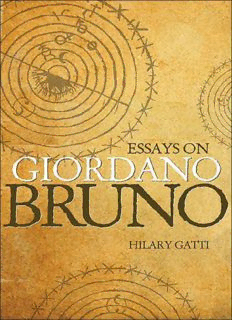
Essays on Giordano Bruno PDF
Preview Essays on Giordano Bruno
ESSAYS ON GIORDANO BRUNO ESSAYS ON GIORDANO BRUNO HILARY GATTI princeton university press princeton and oxford Copyright © 2011 by Princeton University Press Published by Princeton University Press, 41 William Street, Princeton, New Jersey 08540 In the United Kingdom: Princeton University Press, 6 Oxford Street, Woodstock, Oxfordshire OX20 1TW press.princeton.edu All Rights Reserved Library of Congress Cataloging-in-Publication Data Gatti, Hilary. [Essays. English. Selections] Essays on Giordano Bruno / Hilary Gatti. p. cm. Includes bibliographical references and index. ISBN 978-0-691-14574-7 (cloth : alk. paper) — ISBN 978-0-691-14839-7 (pbk. : alk. paper) 1. Bruno, Giordano, 1548-1600. I. Title. B783.Z7G38 2011 195--dc22 2010012090 British Library Cataloging-in-Publication Data is available This book has been composed in Sabon Printed on acid-free paper. ∞ Printed in the United States of America 10 9 8 7 6 5 4 3 2 1 To my friend Ingrid Rowland CONTENTS Preface ix Acknowledgments xiii INTRODUCTION Beginning as Negation in the Italian Dialogues of Giordano Bruno 1 PART 1 BRUNO AND THE NEW SCIENCE 1 Between Magic and Magnetism: Bruno’s Cosmology at Oxford 17 2 Bruno’s Copernican Diagrams 40 3 Bruno and the New Atomism 70 4 The Multiple Languages of the New Science 91 PART 2 BRUNO IN BRITAIN 5 Petrarch, Sidney, Bruno 115 6 The Sense of an Ending in Bruno’s Heroici furori 127 7 Bruno and Shakespeare: Hamlet 140 8 Bruno’s Candelaio and Ben Jonson’s The Alchemist 161 9 Bruno and the Stuart Court Masques 172 10 Romanticism: Bruno and Samuel Taylor Coleridge 201 11 Bruno and the Victorians 220 PART 3 BRUNO’S PHILOSOPHY OF NATURE 12 Bruno’s Natural Philosophy 249 13 Bruno’s Use of the Bible in His Italian Philosophical Dialogues 264 viii CONTENTS 14 Science and Magic: The Resolution of Contraries 280 15 Bruno and Metaphor 297 EPILOGUE Why Bruno’s “A Tranquil Universal Philosophy” Finished in a Fire 309 Bibliography of Cited Works by and on Giordano Bruno 325 Index 335 PREFACE A good question to start with might be: “Why Giordano Bruno?” IT ALL BEGAN WITH A COURSE I was giving on Shakespeare’s Hamlet at the University of Rome “La Sapienza” in Italy. During my reading of a small slice of the daunting amount of critical material on Shakespeare’s tragedy (someone somewhere has done a statistical count and arrived at the conclusion that to read all the criticism dedicated to Hamlet alone would require more than a single life span), I came across a reference to a theory that some of Hamlet’s characteristics might have been based on the life and tragic death of Giordano Bruno, in the Campo dei Fiori (The Field of Flowers), in Rome. Although I was living in Rome at the time, and aware of where the Campo dei Fiori was, and of the imposing statue that dominates that lovely square, I realized that I had little idea of whom the statue was commemorating or why. I dedicated some hours to it, and the next day went on a visit of discovery to the phi- losophy library that constitutes one of the areas of excellence of my erst- while university, where I would spend many hours in the coming years. I brought home with me the dialogue especially mentioned on the page I had been reading, La cena de le ceneri, or The Ash Wednesday Supper, in the Einaudi edition of 1955 edited by Giovanni Aquilecchia—a fine scholar who would soon become a major point of reference throughout my Bruno studies. I remember reading it through in a few hours, get- ting to the end almost out of breath. I found it stunning, overwhelming. What was this? Philosophy or cosmology or drama? Or philosophy and cosmology in the form of a drama? And what kind of language was this? Like no Italian I had ever read or heard anywhere before, either ancient or modern. And how did this man from Nola (where was Nola?) know so much about Elizabethan London? Of one thing only I felt quite sure then, and I have never changed my mind: Shakespeare had been through those pages. Somehow, somewhere, he had either read them or had them read to him. For The Ash Wednesday Supper is an extraordinary theater of conflicting ideas, as indeed (as I would discover later) are all Bruno’s Italian dialogues, and his Latin works as well. But The Ash Wednesday Supper in particular, which I would later translate into English, remained and still remains a center of particular interest and concern: a hub around which would coil and develop in the coming years and decades my vari- ous and varied studies of Bruno’s life and thought.
Description: